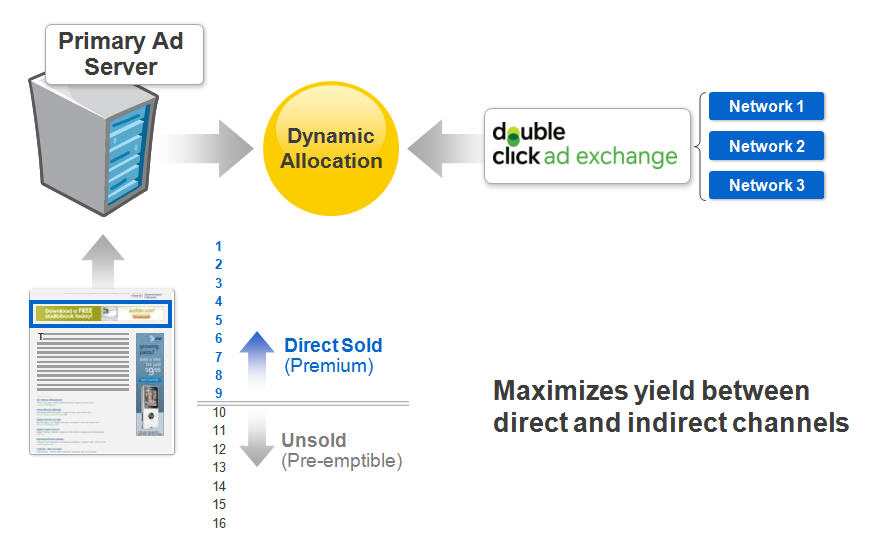
As we all know, display advertising can be operationally difficult across numerous elements. For advertisers, complexities arise in buying inventory, reaching the right users, and understanding the effectiveness of campaigns. With the proliferation of ad networks (over 600 globally), it’s not getting any easier. And the media industry continues to become increasingly fragmented. Just five or six years ago, you could buy on three publishers and reach most of the web; today, those 3 sites are only 23% of page view traffic. On the other side of the equation, some publishers are left with up to 80% of their ad space unsold. It’s like airlines flying with their planes mostly empty. And for the ad space that they do sell, publishers have to deal with the complexity of managing thousands of advertisers and campaigns.
Display advertising needs a solution that connects buyers and sellers when they’re looking for one another without even knowing it; one that provides consistent, transparent, and consolidated data to gauge the impact of campaigns; and has scalable targeting capabilities for both buyers and sellers in order to show relevant and useful ads to the right users at the right moment.
The good news is that Google’s display strategy aims to solve these problems, which in turn will benefit the entire online advertising ecosystem. The DoubleClick Ad Exchange was born from careful observation of these market inefficiencies and is an important step towards fulfilling this vision.
By bringing advertisers and publishers together in an open marketplace where prices are set in a real-time auction, an ad exchange enables display ads and ad space to be allocated much more efficiently. This improves returns for buyers and enables sellers to get the most value out of their online content.
Ad exchanges are neutral platforms that open the display ecosystem and establish a new marketplace with benefits to buyers and sellers. For publishers managing multiple sales channels, the DoubleClick Ad Exchange provides real-time yield management to maximize returns. Participating ad networks and agency networks get access to a large pool of inventory and the controls they need to precisely achieve their marketing goals.
How Ad Exchange Works

Ad Exchange Best Practices:
I recommend that Ad Operations professionals new to the Doubleclick Ad Exchange follow these three best practices:
Use Dynamic Allocation to maximize yield from every channel. Currently only available for DFP. In DFP, set your priority level below your guaranteed inventory, but high enough to give Ad Exchange (AdX) a chance to compete for pre-emptible inventory. You can then create a corresponding ad unit to take advantage of dynamic allocation. We recommend that you create long orders in DFP that won’t require maintenance, because AdX 2.0 does not have start and end dates for ad units.

Configure the Ad Review Center to best suit your business. Review ads in the Ad Review Center by clicking the Allow & block ads tab. You can hold, trust, or block by ad group or advertiser. You can also choose to run ads immediately instead of holding them. This maximizes your earnings potential by allowing ads to run without delay. You can review ads that have already run and select those groups you want to allow or block in the future.
Set up Ad Units with Hybrid Pricing. An ad unit can be offered as anonymous, branded, or both; create one ad unit and specify different minimum CPMs. This allows you to maximize yield for every impression, create a min CPM for branded, and get the most value for your brand name inventory from buyers willing to pay a premium.

It was a pleasure meeting all the attendees of Leadership Forum EU V and feel free to contact me at [email protected] with any questions!
 Kate Herbert manages the Global Ad Exchange Client Services team and is responsible for both buy- and sell-side product implementation, client training, and ongoing account management. She has been with DoubleClick since 2002 and has held a variety of leadership positions, including Director of Solutions Consulting in North America. Kate moved to London in 2007 to launch the 1.0 version of AdX in EMEA.
Kate Herbert manages the Global Ad Exchange Client Services team and is responsible for both buy- and sell-side product implementation, client training, and ongoing account management. She has been with DoubleClick since 2002 and has held a variety of leadership positions, including Director of Solutions Consulting in North America. Kate moved to London in 2007 to launch the 1.0 version of AdX in EMEA.